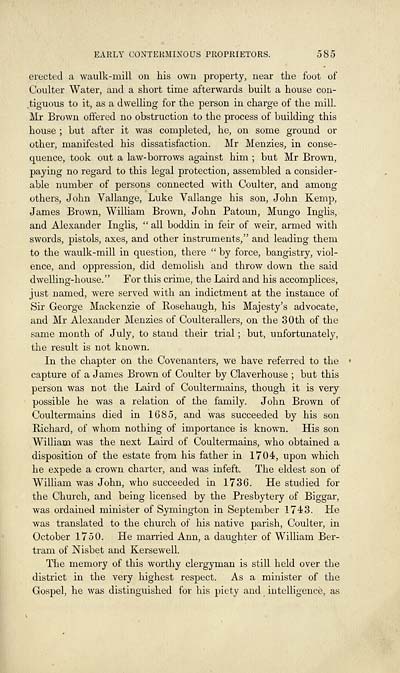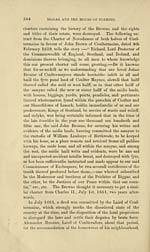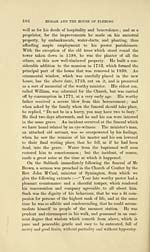Biggar and the House of Fleming
(615) Page 597
Download files
Complete book:
Individual page:
Thumbnail gallery: Grid view | List view

EARLY CONTERMINOUS PROPRIETORS. 585
erected a waulk-mill on his own property, near the foot of
Coulter Water, and a short time afterwards built a house con-
tiguous to it, as a dwelling for the person in charge of the mill.
Mr Brown offered no obstruction to the process of building this
house ; but after it was completed, he, on some ground or
other, manifested his dissatisfaction. Mr Menzies, in conse-
quence, took out a law-borrows against him ; but Mr Brown,
paying no regard to this legal protection, assembled a consider-
able number of persons connected with Coulter, and among
others, John Vallange, Luke Vallange his son, John Kemp,
James Brown, William Brown, John Patoun, Mungo Inglis,
and Alexander Inglis, " all boddin in feir of weir, armed with
swords, pistols, axes, and other instruments," and leading them
to the waulk-mill in question, there " by force, bangistry, viol-
ence, and oppression, did demolish and throw down the said
dwelling-house." For this crime, the Laird and his accomplices,
just named, were served with an indictment at the instance of
Sir George Mackenzie of Rosehaugh, his Majesty's advocate,
and Mr Alexander Menzies of Coulterallers, on the 30th of the
same month of July, to stand their trial ; but, unfortunately,
the result is not known.
In the chapter on the Covenanters, we have referred to the
capture of a James Brown of Coulter by Claverhouse ; but this
person was not the Laird of Coultermains, though it is very
possible he was a relation of the family. John Brown of
Coultermains died in 1685, and was succeeded by his son
Richard, of whom nothing of importance is known. His son
William was the next Laird of Coultermains, who obtained a
disposition of the estate from his father in 1704, upon which
he expede a crown charter, and was infeft. The eldest son of
William was John, who succeeded in 1736. He studied for
the Church, and being licensed by the Presbytery of Biggar,
was ordained minister of Symington in September 1743. He
was translated to the church of his native parish, Coulter, in
October 1750. He married Ann, a daughter of William Ber-
tram of Nisbet and Kersewell.
The memory of this worthy clergyman is still held over the
district in the very highest respect. As a minister of the
Gospel, he was distinguished for his piety and intelligence, as
erected a waulk-mill on his own property, near the foot of
Coulter Water, and a short time afterwards built a house con-
tiguous to it, as a dwelling for the person in charge of the mill.
Mr Brown offered no obstruction to the process of building this
house ; but after it was completed, he, on some ground or
other, manifested his dissatisfaction. Mr Menzies, in conse-
quence, took out a law-borrows against him ; but Mr Brown,
paying no regard to this legal protection, assembled a consider-
able number of persons connected with Coulter, and among
others, John Vallange, Luke Vallange his son, John Kemp,
James Brown, William Brown, John Patoun, Mungo Inglis,
and Alexander Inglis, " all boddin in feir of weir, armed with
swords, pistols, axes, and other instruments," and leading them
to the waulk-mill in question, there " by force, bangistry, viol-
ence, and oppression, did demolish and throw down the said
dwelling-house." For this crime, the Laird and his accomplices,
just named, were served with an indictment at the instance of
Sir George Mackenzie of Rosehaugh, his Majesty's advocate,
and Mr Alexander Menzies of Coulterallers, on the 30th of the
same month of July, to stand their trial ; but, unfortunately,
the result is not known.
In the chapter on the Covenanters, we have referred to the
capture of a James Brown of Coulter by Claverhouse ; but this
person was not the Laird of Coultermains, though it is very
possible he was a relation of the family. John Brown of
Coultermains died in 1685, and was succeeded by his son
Richard, of whom nothing of importance is known. His son
William was the next Laird of Coultermains, who obtained a
disposition of the estate from his father in 1704, upon which
he expede a crown charter, and was infeft. The eldest son of
William was John, who succeeded in 1736. He studied for
the Church, and being licensed by the Presbytery of Biggar,
was ordained minister of Symington in September 1743. He
was translated to the church of his native parish, Coulter, in
October 1750. He married Ann, a daughter of William Ber-
tram of Nisbet and Kersewell.
The memory of this worthy clergyman is still held over the
district in the very highest respect. As a minister of the
Gospel, he was distinguished for his piety and intelligence, as
Set display mode to:
![]() Universal Viewer |
Universal Viewer | ![]() Mirador |
Large image | Transcription
Mirador |
Large image | Transcription
Images and transcriptions on this page, including medium image downloads, may be used under the Creative Commons Attribution 4.0 International Licence unless otherwise stated. ![]()
| Histories of Scottish families > Biggar and the House of Fleming > (615) Page 597 |
|---|
| Permanent URL | https://digital.nls.uk/94846662 |
|---|
| Description | A selection of almost 400 printed items relating to the history of Scottish families, mostly dating from the 19th and early 20th centuries. Includes memoirs, genealogies and clan histories, with a few produced by emigrant families. The earliest family history goes back to AD 916. |
|---|

